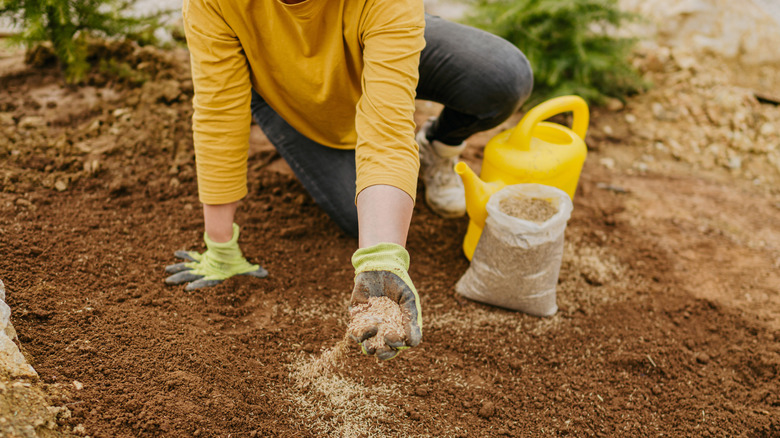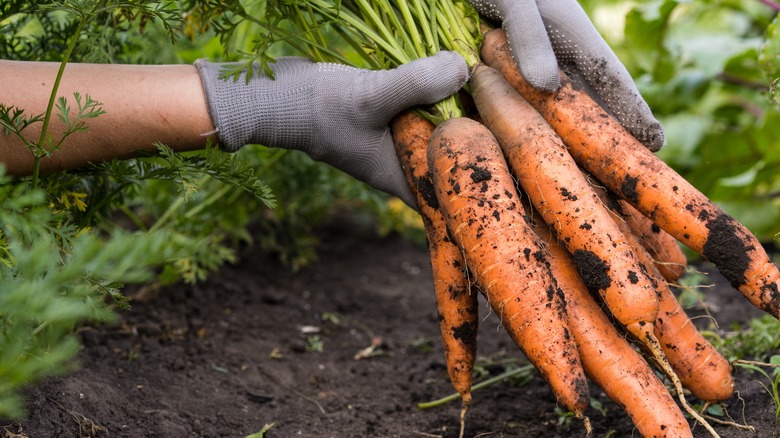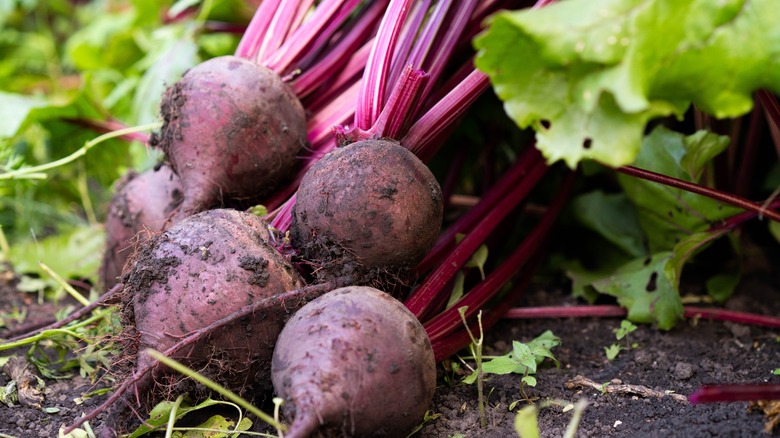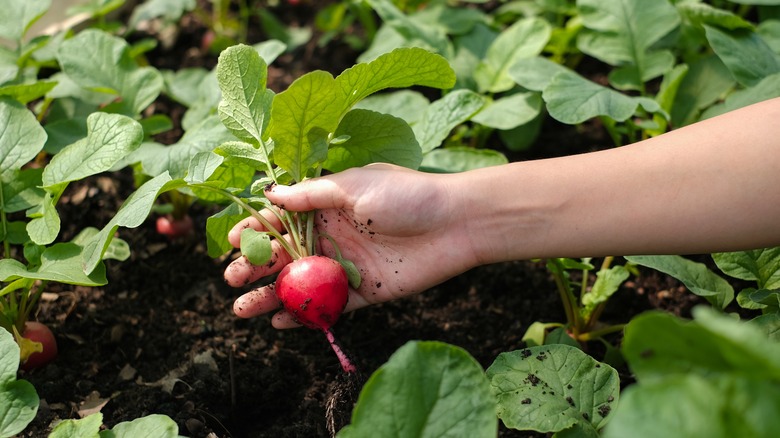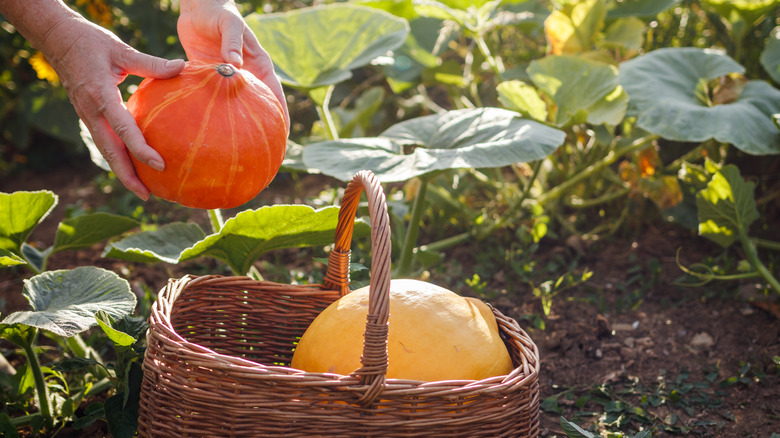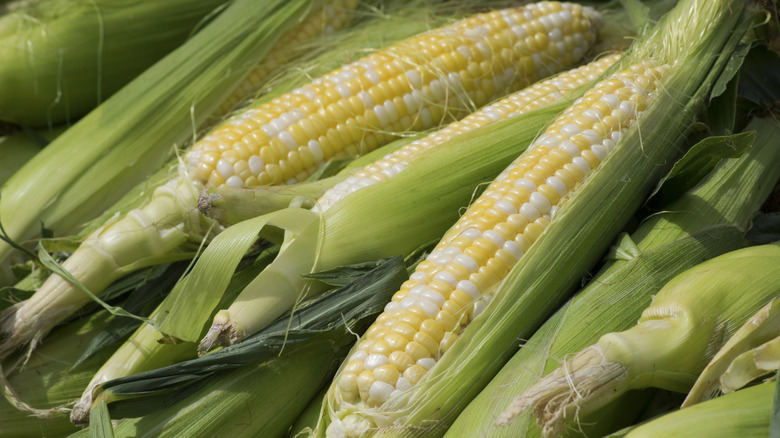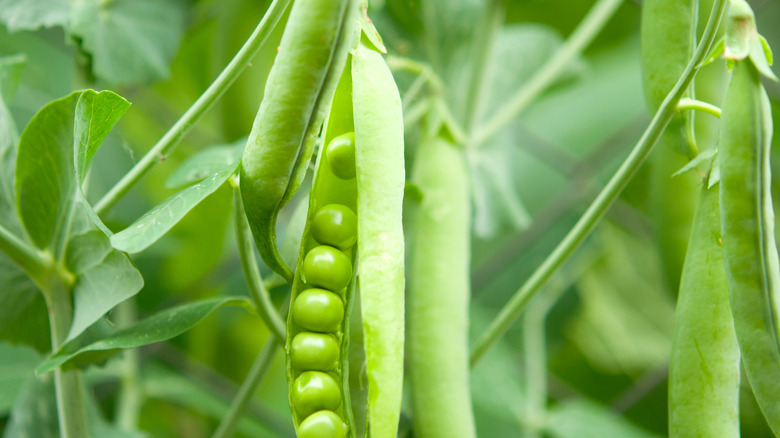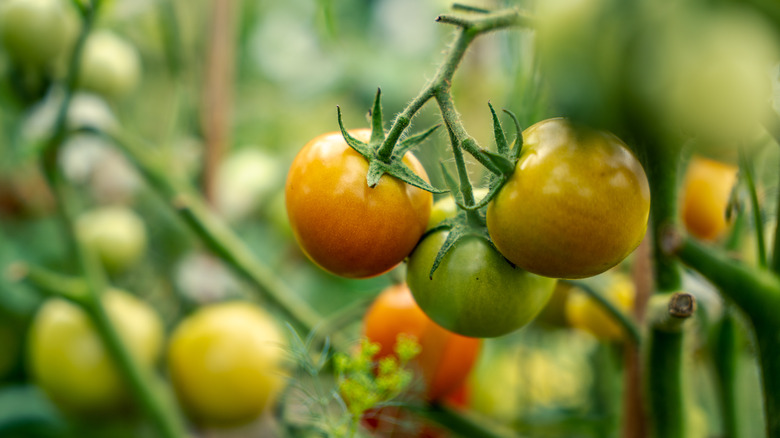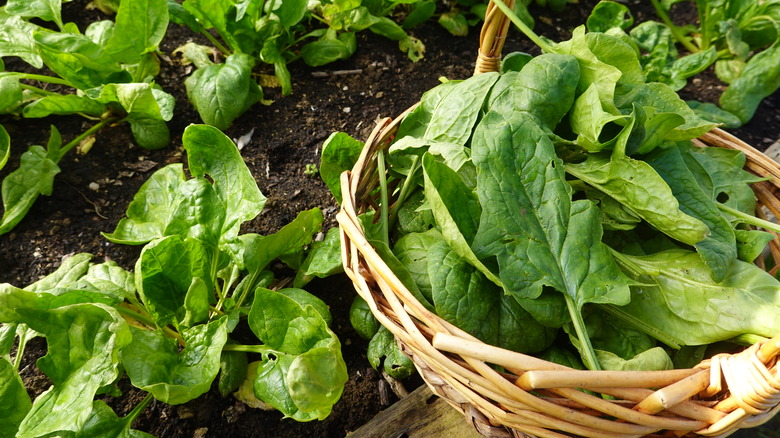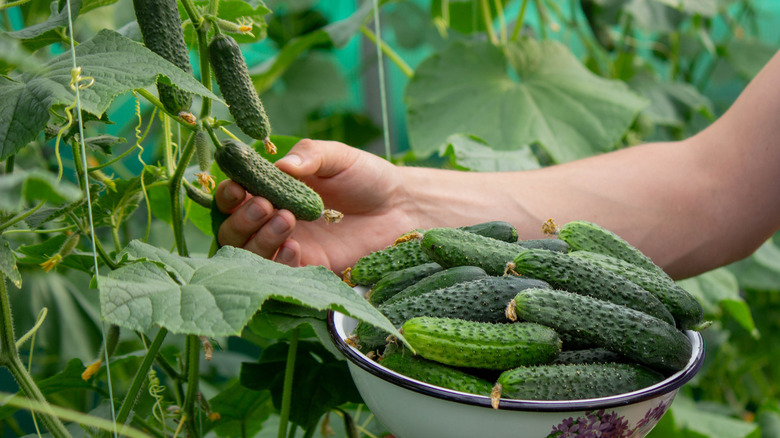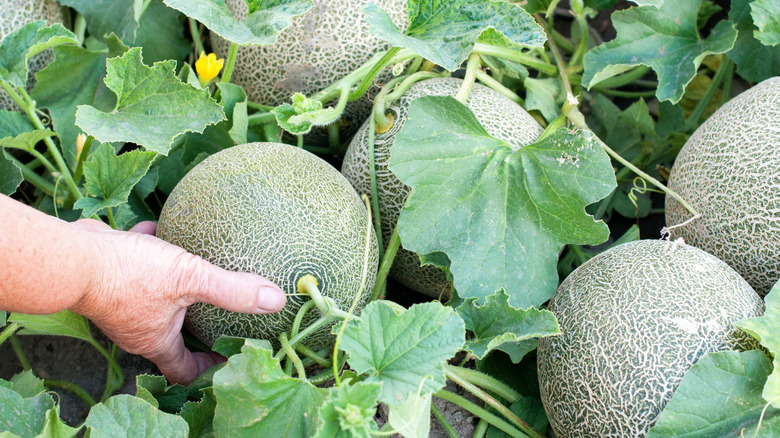10 Easy Fruits And Vegetables To Grow From Seed In Your Own Backyard
We may receive a commission on purchases made from links.
If you have some spare space in your yard and a few minutes to dedicate to plant care, you have the means to grow your own produce. You don't need to be a green-thumbed garden enthusiast to grow fruit and veg from seed. In fact, it's probably much easier than you think. There's a reason why children grow tomatoes and beans for school projects; these plants germinate quickly, don't need a lot of attention, and are very rewarding.
There are many benefits and motivating factors for starting your own food garden. You can save money on your grocery shopping bill, become more self-sufficient, spend more time outdoors, and reduce your carbon footprint. It also allows you to enjoy a diverse range of produce and know exactly where your food has come from. One way to enhance these benefits is to start your plants from seeds. This can save you even more cash and make the entire process even more rewarding as you harvest the produce you've grown from seeds. The key is to start simple. Selecting produce that is easy to grow from seed will ensure you don't fail and give up. Instead, opt for fast-germinating vegetables like radishes, and low-maintenance fruits like cucumbers to spur your interest.
Grow carrots in containers or sow them directly in garden soil
Carrots are a super easy vegetable to grow from seed, and if you sow them in batches every few weeks you'll have a steady supply of fresh carrots to enjoy throughout the growing season. The delicate root system of this vegetable means it doesn't transplant well, since the roots can easily get damaged, affecting the growth of the carrots. Due to this, they are best sown from seed directly in garden soil. Carrots are low-maintenance and require very little care, making them an ideal starter vegetable to grow if you're new to gardening. They are drought tolerant, so you won't need to water them often when grown in ground soil. They take up minimal space which also means they are great for compact gardens, and can even be grown successfully in containers.
Carrot seeds should be planted two to three weeks before the final frost or when soil temperature has reached at least 40 degrees Fahrenheit. Choose a sunny site with well-draining, fertile soil that is free from rocks. You can prep your soil for successful planting beforehand by adding organic matter and fertilizer. Sow the seeds at a depth of between ¼ inch and ½ inch, and thin seedlings out to 3 inches apart. The best carrots are produced with consistent watering, but container-grown carrots will have higher water needs. You can harvest your homegrown carrots between 65 and 75 days after planting the seeds.
Enjoy fresh beets from late summer through to fall with clever seed sowing
Like carrots, beets have a delicate root system that makes them a poor choice for transplanting. Instead, grow them from seed for a very easy and rewarding gardening experience. Since beet seeds are quite large they are straightforward to handle, making them a great choice for small children or anyone with dexterity issues. They take up a small amount of space both above ground and in the soil, so you can grow them even in compact gardens. Beets are the best vegetable to grow if you're a lazy gardener because they are so low maintenance.
Sow beet seeds at a depth of ½ inch in fertile soil. Each seed will produce between two to six beets. Once the leaves reach 3 or 4 inches in height, the beets can be thinned with a distance of 2 to 3 inches between each plant. The soil should be kept moist but not wet throughout the growing season. These vegetables grow quickly and can be harvested as early as 40 days from seed, though most will be ready between 50 and 60 days. You can sow seeds every two to three weeks from early spring through to the middle of summer for a continuous supply of beets. Those harvested in late fall can be stored to enjoy through winter.
Radishes can be harvested just weeks after planting seeds
Radishes are the fastest-growing vegetable to plant in your garden for an early harvest. They grow quickly and are ready to dig up and eat in as little as 20 days, which is ideal for impatient gardeners or anyone who likes (almost!) instant gratification. They are a great choice for a whole host of other reasons too. Radishes are tolerant of cool weather, making them well-suited for growing in a wide range of climates (USDA hardiness zones 2-11). They require little care aside from regular watering and take up a small amount of space. Since these are another type of root vegetable that can be easily damaged during the transplant process, they fare best when sown from seed directly in garden soil.
The best time to sow radish seeds depends on your climate. In cooler climates, plant radishes periodically from early April to early May, and from mid-August to avoid the high temperatures in summer. In hotter areas, it's best to sow radish seeds outdoors through fall and winter, from September through to March. Seeds grow best in sandy, deep, well-draining soil and should be planted at a maximum depth of ¼ inch.
Pumpkins are easy and fun to grow from seed
Pumpkins are great fun to grow from seed, and as long as you live in a climate with long, warm summers, they are a breeze to care for. Pumpkins are ready to harvest in fall so you can have these fruits ready to decorate for Halloween or create some tasty winter dishes like pie or soup. One thing to note about pumpkins is that they, unsurprisingly, require quite a bit of space. They produce extensive root systems and even smaller varieties will take up a substantial area in the garden, so only choose these fruits if you can offer them plenty of growing room.
Pumpkins are sensitive to cold temperatures so they should not be planted outside until the last frost has passed. If you want a head start, you can sow the seeds indoors in mid-spring and transplant them outside in the yard in early summer. Seeds should be sown at a depth of 1 inch in soil that is sandy and high in organic matter. Regular watering of around 1 inch per week is necessary for good growth, so be prepared to supplement in the absence of rain. There are plenty of interesting varieties of pumpkin you can grow at home that you might not find in the grocery store. Try White Lightening seeds, like these from Blue Pumpkin Seed Co., for a fair-skinned pumpkin that would look great decorated as a ghost.
Choose hybrid corn cultivars for easy growing and sweet flavor
Sweet corn can be grown from seed at home easily, as long as you have a sunny site available. After germination, corn can even withstand light frosts, making it a very forgiving vegetable to grow in a range of climates. Gardeners with limited space can grow corn, but your yields may be small because each plant will typically produce one or two ears. Those with larger backyards can enjoy a more bountiful harvest, with the corn ideally planted in rows to encourage pollination. New cultivars of sweet corn are recommended for home growers because these have a higher sugar content and retain their sweetness for longer than traditional varieties.
To grow sweet corn in your garden for a tasty golden harvest you should pay attention to the climate. Though corn can tolerate frost, the temperature of the soil is important for germination, and a range of 60 to 85 degrees Fahrenheit is preferable. Alternatively, sow seeds indoors and transplant seedlings outside around 10 to 14 days after germination. Moisture is essential for corn throughout the growing process, with around 1 inch of water per week recommended. Try growing Yellowstone,which has a sweet taste and a crisp texture, with seeds like these from Urban Farmer.
Pre-germinate peas for a head start on growth
Peas are reliable and easy to grow from seed, whether you choose to sow them outside or start them indoors. Most varieties of peas will be ready after around 60 days, but you can get a head start by pre-germinating them for an earlier harvest. As peas grow on vines, they will need support to grow. You can use metal support frames or create an make your own easy budget-friendly DIY pea trellis. Since vertical growing is an option, you can grow peas in your backyard even if you have limited space. One thing to note is that pea growth is inhibited by acidic soils. Ensure your soil is neutral or alkaline before starting your pea-gardening journey.
Peas are a cool season crop that won't produce pods once the temperatures exceed 85 degrees Fahrenheit, so you'll need to get a head start on growing these seeds in many areas. To pre-germinate pea seeds, moisten some paper towel and set the seeds on top of it, then enclose the whole thing in a clear plastic bag with air holes and store it in a warm spot like a sunny windowsill. Once the seeds have sprouted roots they can be planted outside, providing the soil has thawed. They should be planted at a depth of 1 inch, with 6 to 7 inches between each seedling. Keep an eye on your harvest and pick the peas as soon as the pods look full
Experience different varieties of tomatoes by sowing seeds
It's super easy to grow tomato plants from seed, making them a firm favorite amongst home growers. One of the great things about producing your own tomatoes is that you can enjoy a wide range of varieties you might not ordinarily have the opportunity to taste. Growing tomatoes from seed provides you with an abundance of options, with seed catalogs having many more varieties on offer compared with the seedlings you'll find in nurseries come springtime. You can find tomatoes that are ideal for salads, snacking, or cooking, depending on your preference. Try Candyland from Harris Seeds for miniature, sweet tomatoes, or Cherokee Purple from Eden Brothers for a meaty heirloom tomato that's flushed with pink and purple both inside and out.
Tomato seeds need a soil temperature of between 75 to 85 degrees Fahrenheit to germinate, so it's often best to start them indoors on a warm windowsill or under a grow lamp like this one from Amazon. Use moist potting soil and tuck the seeds in at a depth of a quarter inch, and wait seven to ten days for seedlings to emerge. Once temperatures outside are consistently above 60 degrees Fahrenheit, transplant the seedlings in ground soil or in containers. Tomato plants need support in the form of stakes and garden string to secure the vines. Ensure the soil remains consistently moist and is fed with a vegetable garden fertilizer every two weeks.
Plant fresh spinach seeds for a lush leafy crop
Spinach grows really quickly from seed, making it the perfect choice if you want rapid rewards for your gardening efforts. The leafy green can be enjoyed fresh in salads and sandwiches, or cooked in a stew or stir fry. As a bonus, it's an excellent source of nutrients including iron and magnesium. Spinach plants thrive in full sun. However, they can still do grow well in partial shade, so there's a little flexibility when it comes to the spot for planting your spinach seeds. One thing to note is that spinach seeds deteriorate quickly, so if you want a successful crop, you should be using fresh seeds. If you have seed packets in your kitchen cupboard from years gone by, these are unlikely to yield a great harvest.
Spinach seeds can be planted outside four to eight weeks before the final frost is expected in spring, as they germinate best in cool temperatures ranging between 45 and 68 degrees Fahrenheit. Sow them in a well-draining soil that is rich in organic matter at a depth of half an inch, and thin them out when seedlings appear. The best temperature for growing spinach is 50 to 60 degrees Fahrenheit, however, the seedlings can tolerate much lower temperatures. They are ready to harvest when the leaves appear full size, prior to the plant flowering.
Grow cucumber vines on garden trellises
Cucumbers grow easily from seed, and the fact that they form on a vine means you have numerous options for where to put them. You can grow cucumbers in a container or a grow bag with the aid of a trellis or bamboo stakes, making them perfect for people who don't have a lot of outdoor space for home growing. If space isn't an issue, you can grow them trailing along the ground. Cucumber seedlings transplant with good success rates, so you also have the option of starting seeds indoors and getting a head start on the season, before moving the baby cucumber plants outside to their permanent home.
Plant cucumber seeds 1 inch deep in fertile, well-draining soil. They will germinate in five to ten days, and seedlings can be transplanted when there are several leaves on each plant. Move them to a spot outside that benefits from full sun, and water the plants regularly to avoid letting the soil dry out. Mulching can help to keep the soil moist and also helps to retain warmth. They can be harvested when they reach the full expected size, with mini cucumbers being ready to pick earlier than large varieties.
Sow melon seeds for a series of juicy treats in late summer
Melons need plenty of light and warmth to produce good quality fruit, but if you provide them with the right climate and care conditions you will be rewarded with fast-growing, delicious fruits. If you are concerned that your summers aren't warm enough for long enough to successfully grow melons from seed, avoid watermelon and honeydew as these are more cold-sensitive. Instead, opt for cantaloupe which can tolerate cooler conditions.
In climates with long, hot summers, plant melon seeds outside directly in ground soil about a week before the final frost. In cooler climates, or to get a head start on the season, sow melon seeds indoors in early spring on a warm windowsill or in a heated propagator. Germination will occur in temperatures ranging from 64 to 70 degrees Fahrenheit. Once seedlings have developed, these can be transplanted into a greenhouse for summer, or outside when nighttime temperatures do not drop beneath 53 degrees. Ensure a smooth transition with minimal temperature fluctuations because this can inhibit growth or kill the plant. Melons will grow on vines and need a substantial amount of space. The fruits will ripen at different times, so keep a close eye on them towards the end of summer and harvest each melon individually when it is ready.
